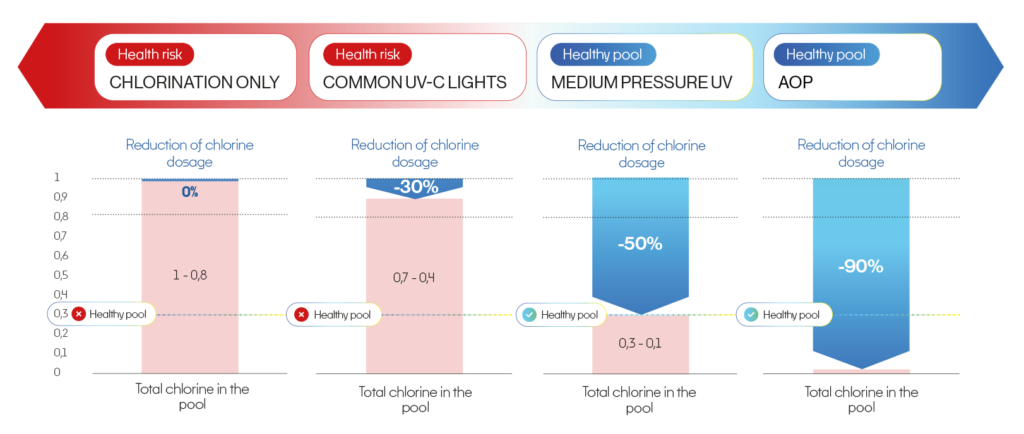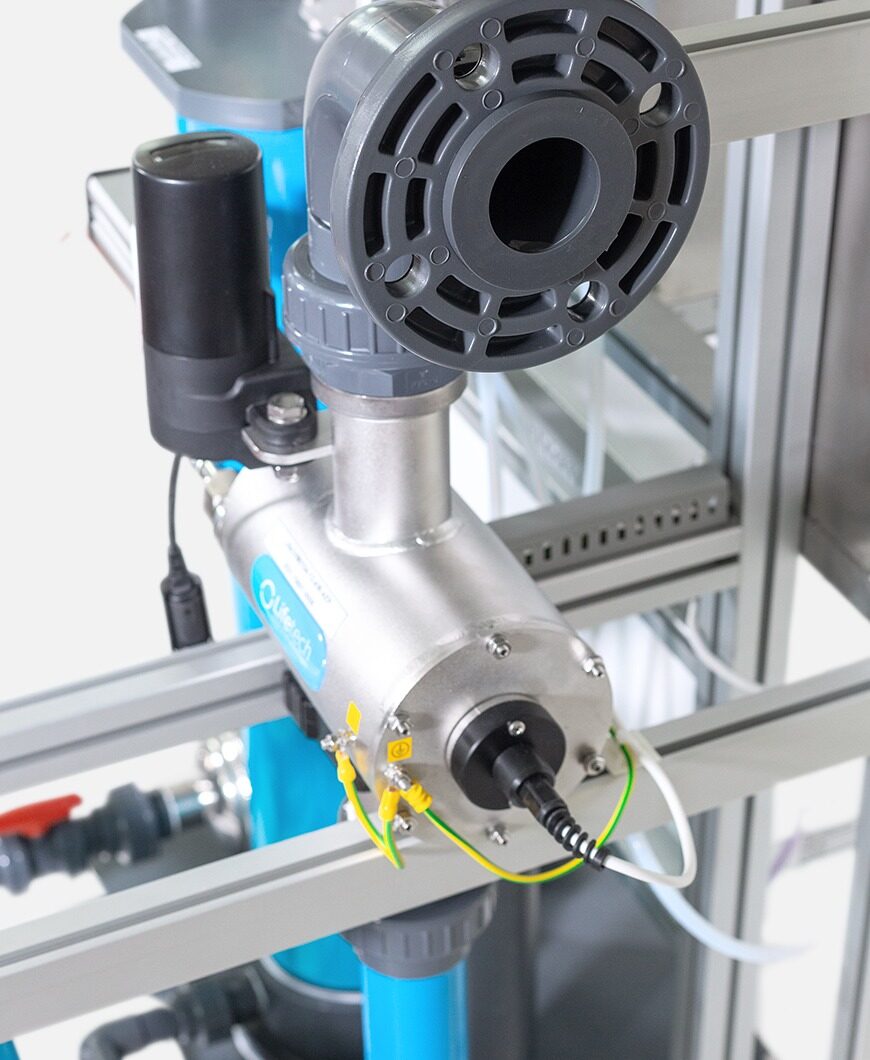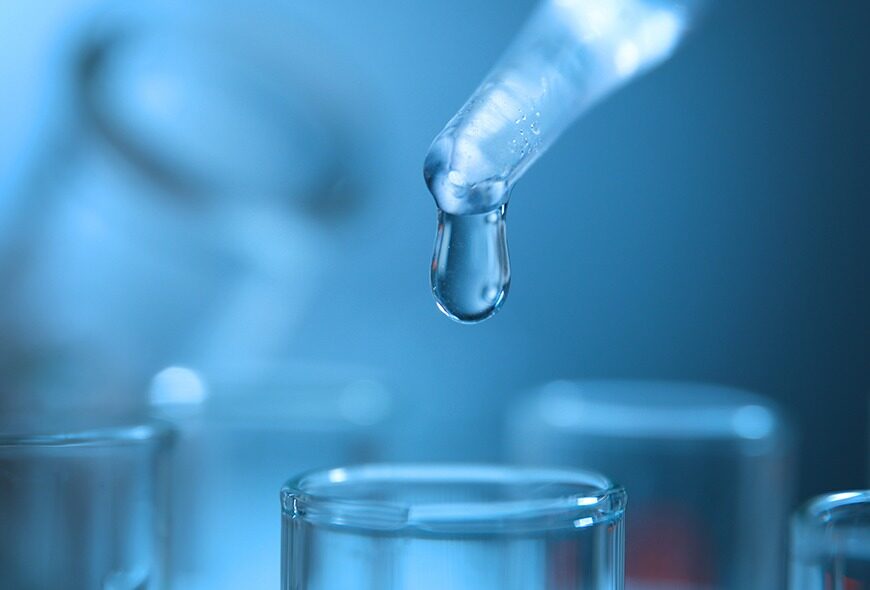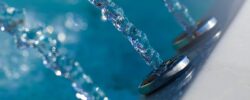Health hazard risks in swimming pools and prevention of healthy risks
Health hazard risks in swimming pools and prevention of healthy risks
Pool chemicals supplemented with a standard filtration device will not guarantee you 100% safe water. Until recently, it was technologically impossible to eliminate certain hazardous substances from the water. Fortunately, the situation has changed. Both fresh and salt water needs to be treated technologically, not just with chlorine. Chlorine has an adverse effect not only on microorganisms in water, but also on human health.

Chlorination only
Swimming pool with high concentrations with trichloramines, NOT a healthy pool
The chemical compound trichloramine ( Part of combined chlorine) becomes carcinogenic at high concentrations and can trigger asthma, allergies, skin irritation and dryness, and eye irritation. It is the compound behind the typical “chlorine” smell associated with swimming pools. In essence, a pool with a strong chlorine smell indicates high levels of bound chlorine and is NOT healthy. Additionally, trichloramine contributes to the corrosion of materials within swimming pools and indoor pool structures. Pools on chlorination and filtration only do are prone to chlorine-resistant bacteria such as Pseudomonas aeruginosa, Legionella, Mycobacterium avium, and Cryptosporidium. These bacteria can withstand typical chlorine concentrations found in pools and can cause severe or even deadly ilnesses. The parasite giardia lamblia – causes severe diarrhoea
Common UV-C lights
These lamps are based on low-pressure UV light bulbs with single wavelength of UV. These lamps do NOT remove the harmful trichloramine!
That harsh “chlorine pool” smell? It’s actually trichloramine, a chemical compound of bound chlorine that is carcinogenic at higher concentrations and linked to asthma, skin irritation, and even damage to pool equipment. The concentration of disinfecting chlorine can be reduced to 0.5 mg/l. The concentration of disinfecting chlorine is 0.7-1 mg/l. Chlorine dosage 100%
Medium pressure UV
Get a healthy swimming pool, removes the harmful Trichloramine
Ensure healthy water and a pleasant environment with UV systems featuring medium-pressure UV lamps, which simultaneously disinfect water and remove harmful Trichloramine. Standard low-pressure UV lamps cannot achieve this, which is why the German standard DIN 19643 for public swimming pool water treatment mandates the use of UV systems with medium-pressure lamps. This advanced technology, previously exclusive to public pools, is now available for private pools. It also allows for the reduction of disinfecting chlorine concentration to 0.3 mg/l.
AOP
Most powerful technology avaiable. Get a healthy swimming pool, removes harmful Trichloramine and its source. Reduce TOC (Total organic carbon)
The pool water attains the quality of drinking water, creating a healthy and pleasant environment suitable even for toddlers, asthmatics, and allergy sufferers. It is free from harmful Trichloramine and organic TOC (Total Organic Carbon) contaminants. The concentration of disinfecting chlorine can be reduced to 0.1-0.2 mg/l. This results in a radical reduction of operating costs and the fastest return on investment.
Health hazards
Trichloramine
The most serious health risk is associated with trichloramine, which is formed by the reaction of chlorine with organic substances contained in pool water, getting into the water mainly through sweat and urine.
It causes
- Upper respiratory tract epithelium irritation and disruption
- Allergic reactions in susceptible persons
- Increased susceptibility to asthma in children and adults
- Eye redness
- Skin irritation and dryness
- Typical pool odor
Trichloramine is found not only in pools with fresh water and classic chlorine disinfection, but also in pools with salt or sea water. This is where chlorine is formed, intended to disinfect the dissolved salt (NaCl) by electrolysis.
Parasites
The second most serious health risk is associated with the occurrence of the parasitic protozoa Cryptosporidium parvum and Giardia lambila, which cause severe diarrhoea, in swimming pools and whirlpools. The attack is also manifested by vomiting, mild fever, abdominal cramps, headaches, loss of appetite or fatigue.
Bacteria
There may be other bacteria in the pool water, such as Escherichia coli causing diarrhoea, urinary tract infection and high fever. The problems caused by Legionella are manifested by headaches and muscle aches, coughing and shortness of breath.
Algae
Algae are not just an aesthetic problem; they release toxic substances into the water. In addition, those in the pool do not have miraculous effects like seaweed and are certainly not a superfood. In general, the higher the concentration of chlorine in the water, the lower the incidence of algae. However, from a health point of view, the concentration of chlorine in water should be kept as low as possible.
It might interest you

Why is Lifetech’s unique technology LifeOX® M the best available technology for pool treatment
Technology
LifeOX® technology provides the highest possible oxidation potential within AOP
Technology
Swimming pools and their health risks: what is not talked about and how to prevent the risks
Healthy pool



